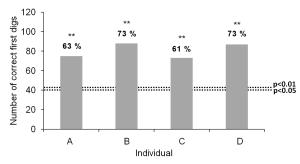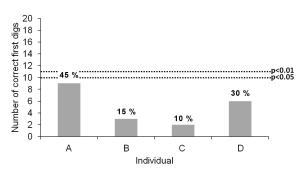Findings
Olfactory detection of real food

The meerkats were able to find all four food types (with the exception of one individual for the mealworms) significantly more often than expected by chance, shown by performing the first dig in the corner bearing the hidden food item.
Discrimination between real food and a food odour component

The meerkats were able to distinguish between the odour of real food and the food odour component, shown by the choice of digging for the food item significantly more often than for the odour. The same result was found when testing real food against the control odour.
Association between real food and a novel odour

As for the ability of the meerkats to associate the odour of real food with a novel odour, this study could not demonstrate any signs of successful association-building.
All four animals significantly performed above chance level (p<0.01 for all four individuals) when performing the first dig in the corner bearing the food plus novel odour. However, none of the four animals performed above chance level (p>0.05 for all four individuals) when performing the first dig in the corner bearing the novel odour only.
Responsible for this page:
Director of undergraduate studies Biology
Last updated:
05/02/18
